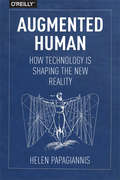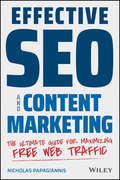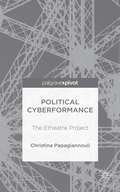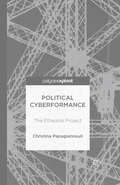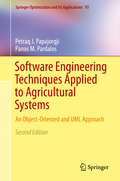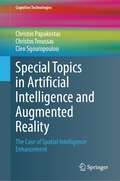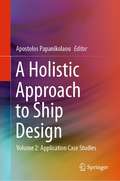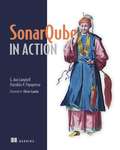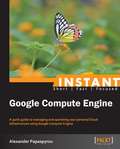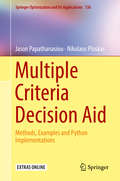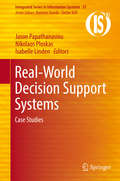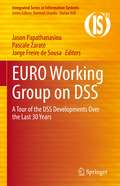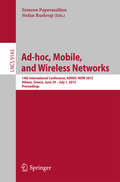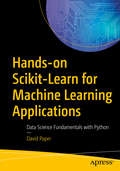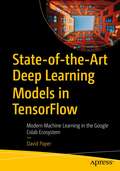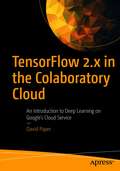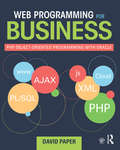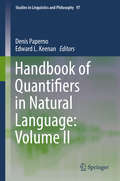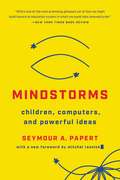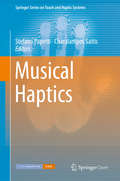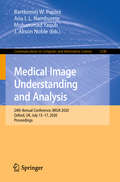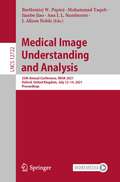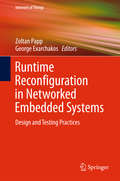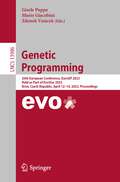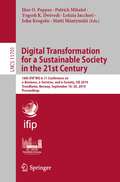- Table View
- List View
Augmented Human: How Technology Is Shaping the New Reality
by Helen PapagiannisAugmented Reality (AR) blurs the boundary between the physical and digital worlds. In AR’s current exploration phase, innovators are beginning to create compelling and contextually rich applications that enhance a user’s everyday experiences. In this book, Dr. Helen Papagiannis—a world-leading expert in the field—introduces you to AR: how it’s evolving, where the opportunities are, and where it’s headed.If you’re a designer, developer, entrepreneur, student, educator, business leader, artist, or simply curious about AR’s possibilities, this insightful guide explains how you can become involved with an exciting, fast-moving technology.You’ll explore how:Computer vision, machine learning, cameras, sensors, and wearables change the way you see the worldHaptic technology syncs what you see with how something feelsAugmented sound and hearables alter the way you listen to your environmentDigital smell and taste augment the way you share and receive informationNew approaches to storytelling immerse and engage users more deeplyUsers can augment their bodies with electronic textiles, embedded technology, and brain-controlled interfacesHuman avatars can learn our behaviors and act on our behalf
Effective SEO and Content Marketing: The Ultimate Guide for Maximizing Free Web Traffic
by Nicholas PapagiannisGet beyond the basics and see how modern-day users are reimaging the SEO process SEO is often underutilized and overlooked across the marketing realm today. SEO is not merely trying to improve your website ranking on Google, but it can spark and optimize ideas. Above all it can help improve the amount of free traffic coming to your web properties. This book provides you with a comprehensive approach to make sure marketing spend is utilized as effectively as possible and deliver the best ROI for your brand and business. Maximizing your organic (free) traffic channels should be a top priority and this book will provide you with insight on how to do that. From working with social media influencers to steering creative ideas and campaigns, modern day SEO requires a full-service perspective of marketing and its processes. General education on SEO and organic content marking Understanding which search engines to focus on How SEO and content can solve business problems Building a new brand through SEO and content Identifying who your true competitors are Which Analytics reports you should be regularly monitoring How to establish research channels that can inform your business initiatives Building personas and audience purchase journeys Prioritizing locations, demographics and countries What needs to be in place to maximize free traffic levels to your brands assets Understanding all the key tasks and attributes for an effective content program Data-Driven Content: Detailed instruction on how to use data to inform content responses, ideas and asset types Understanding different content asset types from standard items like articles to highly advanced assets like films, podcasts, white papers and other assets Calculating ROI for SEO and Content initiatives Small business marketing via content and SEO and having the right small business mindset for success Website and content design considerations (accessibility, principles of marketing) Optimizing for the future and looking at other search venues Amazon Optimization YouTube Optimization App Store Optimization (ASO) Podcast Optimization Optimizing Blogs and other off-site content Prepping and optimizing for the newest technologies, including voice search, artificial intelligence, and content discovery vehicles How to build an optimization path and programs that drive results and manage risks In addition to learning the most effective processes to structure your SEO, you will have access to bonus materials that accompany this book which will include worksheets, checklists, creative brief examples, quizzes, and best interview questions when hiring an SEO specialist. Modern-day marketers, business owners, and brand managers, this book is for you!
Political Cyberformance: The Etheatre Project
by Christina PapagiannouliWritten from a practice-based perspective, this book focuses on the political character of 'cyberformance': the genre of digital performance that uses the Internet as a performance space. The Etheatre Project comprises a series of experimental cyberformances aiming to reconsider the characteristics of theatre in the Internet age.
Software Engineering Techniques Applied to Agricultural Systems
by Petraq J. Papajorgji Panos M. PardalosSoftware Engineering Techniques Applied to Agricultural Systems presents cutting-edge software engineering techniques for designing and implementing better agricultural software systems based on the object-oriented paradigm and the Unified Modeling Language (UML). The focus is on the presentation of rigorous step-by-step approaches for modeling flexible agricultural and environmental systems, starting with a conceptual diagram representing elements of the system and their relationships. Furthermore, diagrams such as sequential and collaboration diagrams are used to explain the dynamic and static aspects of the software system. This second edition includes: a new chapter on Object Constraint Language (OCL), a new section dedicated to the Model-VIEW-Controller (MVC) design pattern, new chapters presenting details of two MDA-based tools - the Virtual Enterprise and Olivia Nova and a new chapter with exercises on conceptual modeling. It may be highly useful to undergraduate and graduate students as the first edition has proven to be a useful supplementary textbook for courses in mathematical programming in agriculture, ecology, information technology, agricultural operations research methods, agronomy and soil science and applied mathematical modeling. The book has broad appeal for anyone involved in software development projects in agriculture and to researchers in general who are interested in modeling complex systems. From the reviews of the first edition: "The book will be useful for those interested in gaining a quick understanding of current software development techniques and how they are applied in practice. . . this is a good introductory text on the application of OOAD, UML and design patters to the creation of agricultural systems. It is technically sound and well written. " --Computing Reviews, September 2006
Special Topics in Artificial Intelligence and Augmented Reality: The Case of Spatial Intelligence Enhancement (Cognitive Technologies)
by Christos Papakostas Christos Troussas Cleo SgouropoulouThis monograph explores the synergy of Artificial Intelligence (AI), Augmented Reality (AR) and cognitive processes to enhance spatial abilities — an integral aspect of cognitive development. The ability to comprehend and manipulate spatial information is not only fundamental to our understanding of the physical world but also plays a pivotal role in numerous academic and professional fields. Recognizing the profound impact of spatial ability on scientific disciplines and educational achievement, this monograph takes on the challenge of enhancing spatial skills among users.The authors present the design and development of a mobile training system that incorporates AR features to enhance learners’ spatial ability. Involving mental generation, transformation, and rotation of visual images for understanding spatial relationships, spatial ability is closely linked to success in various scientific disciplines and educational pursuits. While spatial visualization skills tests are available, this monograph takes a unique approach by focusing on developing targeted interventions to improve spatial ability. It aims to unlock new avenues for cognitive growth and dive into the untapped potential within the realm of spatial intelligence. Beyond its emphasis on spatial ability enhancement, this monograph goes above and beyond traditional approaches by integrating AI techniques into the training system. As such, it aims to provide personalized and adaptive learning experiences for learners. The training system, through intelligent techniques, dynamically analyzes individual learners’ strengths, weaknesses, and progress, tailoring content and challenges to their specific needs. This effort establishes a new frontier in educational technology, offering a groundbreaking solution that not only augments spatial ability development but also showcases the transformative potential of AI in reshaping the learning experience.The book is a valuable resource for researchers, educators, developers and technology enthusiasts, as it exemplifies the profound impact of AI and AR in shaping the future of online learning experiences.
A Holistic Approach to Ship Design: Volume 2: Application Case Studies
by Apostolos PapanikolaouThis book deals with modern Computer-Aided Design (CAD) software tools and platforms implemented in ship design, the integration of techno-economic databases, the use of optimisation and simulation software tools, which are integrated in these platforms, and the virtual modelling of ships and their operation by using a Virtual Vessel Framework (VVF). It contains a series of application case studies related to the developed holistic approach to ship design and operation. Nine case studies are described, referring to the design and operation of various ship types, namely RoPax, cruise ship, double-ended ferry, bulk carrier, containership, offshore support vessel, ocean surveillance ship and research vessel and one offshore structure. All case studies are driven by leading representatives of the European Maritime Industry. This book complements A Holistic Approach to Ship Design, volume 1, which covers methods and tools for the life cycle optimisation and assessment of ship design and operation.
SonarQube in Action
by Patroklos PapapetrouSummarySonarQube in Action shows developers how to use the SonarQube platform to help them continuously improve their source code. The book presents SonarQube's core Seven Axes of Quality: design/architecture, duplications, comments, unit tests, complexity, potential bugs, and coding rules. You'll find simple, easy-to-follow discussion and examples as you learn to integrate SonarQube into your development process.About the TechnologySonarQube is a powerful open source tool for continuous inspection, a process that makes code quality analysis and reporting an integral part of the development lifecycle. Its unique dashboards, rule-based defect analysis, and tight build integration result in improved code quality without disruption to developer workflow. It supports many languages, including Java, C, C++, C#, PHP, and JavaScript.About the BookSonarQube in Action teaches you how to effectively use SonarQube following the continuous inspection model. This practical book systematically explores SonarQube's core Seven Axes of Quality (design, duplications, comments, unit tests, complexity, potential bugs, and coding rules). With well-chosen examples, it helps you learn to use SonarQube's review functionality and IDE integration to implement continuous inspection best practices in your own quality management process.The book's Java-based examples translate easily to other development languages. No prior experience with SonarQube or continuous delivery practice is assumedPurchase of the print book includes a free eBook in PDF, Kindle, and ePub formats from Manning Publications.What's InsideGather meaningful quality metricsIntegrate with Ant, Maven, and JenkinsWrite your own pluginsMaster the art of continuous inspectionAbout the AuthorsAnn Campbellb and Patroklos Papapetrou are experienced developers and team leaders. Both actively contribute to the SonarQube community.Table of ContentsPART 1 WHAT THE NUMBERS ARE TELLING YOUAn introduction to SonarQubeIssues and coding standardsEnsuring that your code is doing things rightWorking with duplicate codeOptimizing source code documentationKeeping your source code files elegantImproving your application designPART 2 SETTLING IN WITH SONARQUBEPlanning a strategy and expanding your insightContinuous Inspection with SonarQubeLetting SonarQube drive code reviewsIDE integrationPART 3 ADMINISTERING AND EXTENDINGSecurity: users, groups, and rolesRule profile administrationMaking SonarQube fit your needsManaging your projectsWriting your own plugins
Instant Google Compute Engine
by Alexander PapaspyrouGet to grips with a new technology, understand what it is and what it can do for you, and then get to work with the most important features and tasks. This book is a step-by-step guide to installing and using Google Compute Engine."Instant Google Compute Engine" is great for developers and operators who are new to Cloud computing, and who are looking to get a good grounding in using Infrastructure-as-a-Service as part of their daily work. It's assumed that you will have some experience with the Linux operating system as well as familiarity with the concept of virtualization technologies, such as VMware, Xen, or Hyper-V. Readers are expected to have a credit card available, which will be necessary for using Google Compute Engine to run the book's examples on their own.
Multiple Criteria Decision Aid: Methods, Examples and Python Implementations (Springer Optimization and Its Applications #136)
by Jason Papathanasiou Nikolaos PloskasMultiple criteria decision aid (MCDA) methods are illustrated in this book through theoretical and computational techniques utilizing Python. Existing methods are presented in detail with a step by step learning approach. Theoretical background is given for TOPSIS, VIKOR, PROMETHEE, SIR, AHP, goal programming, and their variations. Comprehensive numerical examples are also discussed for each method in conjunction with easy to follow Python code. Extensions to multiple criteria decision making algorithms such as fuzzy number theory and group decision making are introduced and implemented through Python as well. Readers will learn how to implement and use each method based on the problem, the available data, the stakeholders involved, and the various requirements needed. Focusing on the practical aspects of the multiple criteria decision making methodologies, this book is designed for researchers, practitioners and advanced graduate students in the applied mathematics, information systems, operations research and business administration disciplines, as well as other engineers and scientists oriented in interdisciplinary research. Readers will greatly benefit from this book by learning and applying various MCDM/A methods. (Adiel Teixeira de Almeida, CDSID-Center for Decision System and Information Development, Universidade Federal de Pernambuco, Recife, Brazil) Promoting the development and application of multicriteria decision aid is essential to ensure more ethical and sustainable decisions. This book is a great contribution to this objective. It is a perfect blend of theory and practice, providing potential users and researchers with the theoretical bases of some of the best-known methods as well as with the computing tools needed to practice, to compare and to put these methods to use. (Jean-Pierre Brans, Vrije Universiteit Brussel, Brussels, Belgium) This book is intended for researchers, practitioners and students alike in decision support who wish to familiarize themselves quickly and efficiently with multicriteria decision aiding algorithms. The proposed approach is original, as it presents a selection of methods from the theory to the practical implementation in Python, including a detailed example. This will certainly facilitate the learning of these techniques, and contribute to their effective dissemination in applications. (Patrick Meyer, IMT Atlantique, Lab-STICC, Univ. Bretagne Loire, Brest, France)
Real-World Decision Support Systems
by Jason Papathanasiou Nikolaos Ploskas Isabelle LindenThis book presents real-world decision support systems, i. e. , systems that have been running for some time and as such have been tested in real environments and complex situations; the cases are from various application domains and highlight the best practices in each stage of the system's life cycle, from the initial requirements analysis and design phases to the final stages of the project. Each chapter provides decision-makers with recommendations and insights into lessons learned so that failures can be avoided and successes repeated. For this reason unsuccessful cases, which at some point of their life cycle were deemed as failures for one reason or another, are also included. All decision support systems are presented in a constructive, coherent and deductive manner to enhance the learning effect. It complements the many works that focus on theoretical aspects or individual module design and development by offering 'good' and 'bad' practices when developing and using decision support systems. Combining high-quality research with real-world implementations, it is of interest to researchers and professionals in industry alike.
EURO Working Group on DSS: A Tour of the DSS Developments Over the Last 30 Years (Integrated Series in Information Systems)
by Jason Papathanasiou Pascale Zaraté Jorge Freire de SousaThis book recapitulates the major developments in Decision Support Systems (DSS) over the last 30 years in order to evaluate the research areas of decision making and in which direction the field should proceed. As it attempts to find a consensus about the next steps for the future of DSS research, the book also enforces the trends and new technologies currently in use. The book examines topics such as decision analysis for enterprise systems and non-hierarchical networks, integrated solutions for decision support and knowledge management in distributed environments, decision support system evaluation and analysis through social networks, and e-learning and its application to real environments. It clearly presents the evidence to support their cases and attempts to promote an extensive and objective discussion. In addition, the book also reflects on approaches to dead-end ideas and failures in DSS to better understand the lessons learned. The contributions for this book have been written by thought leaders and influential researchers from the EURO Working Group of Decision Support Systems (EWG-DSS).
Ad-hoc, Mobile, and Wireless Networks: 14th International Conference, ADHOC-NOW 2015, Athens, Greece, June 29 -- July 1, 2015, Proceedings (Lecture Notes in Computer Science #9143)
by Symeon Papavassiliou Stefan RuehrupThis book constitutes the proceedings of the 14th International Conference on Ad Hoc Networks and Wireless, ADHOC-NOW 2015, held in Athens, Greece in June/July 2015. The 25 full papers presented in this volume were carefully reviewed and selected from 52 submissions. The book also contains 3 full-paper invited talks. The contributions are organized in topical sections named: routing, connectivity, and resource allocation; localization, sensor deployment, and mobility management; distributed computing with mobile agents; efficient, reliable, and secure smart energy networks; and emerging communications, networking and computing technologies for VANETs 2. 0.
Hands-on Scikit-Learn for Machine Learning Applications: Data Science Fundamentals with Python
by David PaperAspiring data science professionals can learn the Scikit-Learn library along with the fundamentals of machine learning with this book. The book combines the Anaconda Python distribution with the popular Scikit-Learn library to demonstrate a wide range of supervised and unsupervised machine learning algorithms. Care is taken to walk you through the principles of machine learning through clear examples written in Python that you can try out and experiment with at home on your own machine.All applied math and programming skills required to master the content are covered in this book. In-depth knowledge of object-oriented programming is not required as working and complete examples are provided and explained. Coding examples are in-depth and complex when necessary. They are also concise, accurate, and complete, and complement the machine learning concepts introduced. Working the examples helps to build the skills necessary to understand and apply complex machine learning algorithms.Hands-on Scikit-Learn for Machine Learning Applications is an excellent starting point for those pursuing a career in machine learning. Students of this book will learn the fundamentals that are a prerequisite to competency. Readers will be exposed to the Anaconda distribution of Python that is designed specifically for data science professionals, and will build skills in the popular Scikit-Learn library that underlies many machine learning applications in the world of Python.What You'll LearnWork with simple and complex datasets common to Scikit-LearnManipulate data into vectors and matrices for algorithmic processingBecome familiar with the Anaconda distribution used in data scienceApply machine learning with Classifiers, Regressors, and Dimensionality ReductionTune algorithms and find the best algorithms for each datasetLoad data from and save to CSV, JSON, Numpy, and Pandas formatsWho This Book Is ForThe aspiring data scientist yearning to break into machine learning through mastering the underlying fundamentals that are sometimes skipped over in the rush to be productive. Some knowledge of object-oriented programming and very basic applied linear algebra will make learning easier, although anyone can benefit from this book.
State-of-the-Art Deep Learning Models in TensorFlow: Modern Machine Learning in the Google Colab Ecosystem
by David PaperUse TensorFlow 2.x in the Google Colab ecosystem to create state-of-the-art deep learning models guided by hands-on examples. The Colab ecosystem provides a free cloud service with easy access to on-demand GPU (and TPU) hardware acceleration for fast execution of the models you learn to build. This book teaches you state-of-the-art deep learning models in an applied manner with the only requirement being an Internet connection. The Colab ecosystem provides everything else that you need, including Python, TensorFlow 2.x, GPU and TPU support, and Jupyter Notebooks. The book begins with an example-driven approach to building input pipelines that feed all machine learning models. You will learn how to provision a workspace on the Colab ecosystem to enable construction of effective input pipelines in a step-by-step manner. From there, you will progress into data augmentation techniques and TensorFlow datasets to gain a deeper understanding of how to work with complex datasets. You will find coverage of Tensor Processing Units (TPUs) and transfer learning followed by state-of-the-art deep learning models, including autoencoders, generative adversarial networks, fast style transfer, object detection, and reinforcement learning. Author Dr. Paper provides all the applied math, programming, and concepts you need to master the content. Examples range from relatively simple to very complex when necessary. Examples are carefully explained, concise, accurate, and complete. Care is taken to walk you through each topic through clear examples written in Python that you can try out and experiment with in the Google Colab ecosystem in the comfort of your own home or office. What You Will LearnTake advantage of the built-in support of the Google Colab ecosystemWork with TensorFlow data setsCreate input pipelines to feed state-of-the-art deep learning modelsCreate pipelined state-of-the-art deep learning models with clean and reliable Python codeLeverage pre-trained deep learning models to solve complex machine learning tasksCreate a simple environment to teach an intelligent agent to make automated decisionsWho This Book Is ForReaders who want to learn the highly popular TensorFlow deep learning platform, those who wish to master the basics of state-of-the-art deep learning models, and those looking to build competency with a modern cloud service tool such as Google Colab
TensorFlow 2.x in the Colaboratory Cloud: An Introduction to Deep Learning on Google’s Cloud Service
by David PaperUse TensorFlow 2.x with Google's Colaboratory (Colab) product that offers a free cloud service for Python programmers. Colab is especially well suited as a platform for TensorFlow 2.x deep learning applications. You will learn Colab’s default install of the most current TensorFlow 2.x along with Colab’s easy access to on-demand GPU hardware acceleration in the cloud for fast execution of deep learning models. This book offers you the opportunity to grasp deep learning in an applied manner with the only requirement being an Internet connection. Everything else—Python, TensorFlow 2.x, GPU support, and Jupyter Notebooks—is provided and ready to go from Colab. The book begins with an introduction to TensorFlow 2.x and the Google Colab cloud service. You will learn how to provision a workspace on Google Colab and build a simple neural network application. From there you will progress into TensorFlow datasets and building input pipelines in support of modeling and testing. You will find coverage of deep learning classification and regression, with clear code examples showing how to perform each of those functions. Advanced topics covered in the book include convolutional neural networks and recurrent neural networks. This book contains all the applied math and programming you need to master the content. Examples range from simple to relatively complex when necessary to ensure acquisition of appropriate deep learning concepts and constructs. Examples are carefully explained, concise, accurate, and complete to perfectly complement deep learning skill development. Care is taken to walk you through the foundational principles of deep learning through clear examples written in Python that you can try out and experiment with using Google Colab from the comfort of your own home or office.What You Will LearnBe familiar with the basic concepts and constructs of applied deep learningCreate machine learning models with clean and reliable Python codeWork with datasets common to deep learning applicationsPrepare data for TensorFlow consumptionTake advantage of Google Colab’s built-in support for deep learningExecute deep learning experiments using a variety of neural network modelsBe able to mount Google Colab directly to your Google Drive accountVisualize training versus test performance to see model fitWho This Book Is ForReaders who want to learn the highly popular TensorFlow 2.x deep learning platform, those who wish to master deep learning fundamentals that are sometimes skipped over in the rush to be productive, and those looking to build competency with a modern cloud service tool such as Google Colab
Web Programming for Business: PHP Object-Oriented Programming with Oracle
by David PaperWeb Programming for Business: PHP Object-Oriented Programming with Oracle focuses on fundamental PHP coding, giving students practical, enduring skills to solve data and technical problems in business. Using Oracle as the backend database, the book is version-neutral, teaching students code that will still work even with changes to PHP and Oracle. The code is clean, clearly explained and solutions-oriented, allowing students to understand how technologies such as XML, RSS or AJAX can be leveraged in business applications. The book is fully illustrated with examples, and includes chapters on: Database functionality Security programming Transformation programming to move data Powerpoint slides, applied exam questions, and the raw code for all examples are available on a companion website. This book offers an innovative approach that allows anyone with basic SQL and HTML skills to learn PHP object-oriented programming.
Handbook of Quantifiers in Natural Language: Volume II
by Denis Paperno Edward L. KeenanThis work presents the structure, distribution and semantic interpretation of quantificational expressions in languages from diverse language families and typological profiles. The current volume pays special attention to underrepresented languages of different status and endangerment level. Languages covered include American and Russian Sign Languages, and sixteen spoken languages from Africa, Australia, Papua, the Americas, and different parts of Asia. The articles respond to a questionnaire the editors constructed to enable detailed crosslinguistic comparison of numerous features. They offer comparable information on semantic classes of quantifiers (generalized existential, generalized universal, proportional, partitive), syntactically complex quantifiers (intensive modification, Boolean compounds, exception phrases, etc. ), and several more specific issues such as quantifier scope ambiguities, floating quantifiers, and binary (type 2) quantifiers. The book is intended for semanticists, logicians interested in quantification in natural language, and general linguists as articles are meant to be descriptive and theory independent. The book continues and expands the coverage of the Handbook of Quantifiers in Natural Language (2012) by the same editors, and extends the earlier work in Matthewson (2008), Gil et al. (2013) and Bach et al (1995).
Mindstorms: Children, Computers, And Powerful Ideas
by Seymour A. PapertIn this revolutionary book, a renowned computer scientist explains the importance of teaching children the basics of computing and how it can prepare them to succeed in the ever-evolving tech world.Computers have completely changed the way we teach children. We have Mindstorms to thank for that. In this book, pioneering computer scientist Seymour Papert uses the invention of LOGO, the first child-friendly programming language, to make the case for the value of teaching children with computers. Papert argues that children are more than capable of mastering computers, and that teaching computational processes like de-bugging in the classroom can change the way we learn everything else. He also shows that schools saturated with technology can actually improve socialization and interaction among students and between students and teachers.Technology changes every day, but the basic ways that computers can help us learn remain. For thousands of teachers and parents who have sought creative ways to help children learn with computers, Mindstorms is their bible.
Musical Haptics (Springer Series on Touch and Haptic Systems)
by Stefano Papetti Charalampos SaitisThis open access book offers an original interdisciplinary overview of the role of haptic feedback in musical interaction. Divided into two parts, part I examines the tactile aspects of music performance and perception, discussing how they affect user experience and performance in terms of usability, functionality and perceived quality of musical instruments. Part II presents engineering, computational, and design approaches and guidelines that have been applied to render and exploit haptic feedback in digital musical interfaces. Musical Haptics introduces an emerging field that brings together engineering, human-computer interaction, applied psychology, musical aesthetics, and music performance. The latter, defined as the complex system of sensory-motor interactions between musicians and their instruments, presents a well-defined framework in which to study basic psychophysical, perceptual, and biomechanical aspects of touch, all of which will inform the design of haptic musical interfaces. Tactile and proprioceptive cues enable embodied interaction and inform sophisticated control strategies that allow skilled musicians to achieve high performance and expressivity. The use of haptic feedback in digital musical interfaces is expected to enhance user experience and performance, improve accessibility for disabled persons, and provide an effective means for musical tuition and guidance.
Medical Image Understanding and Analysis: 24th Annual Conference, MIUA 2020, Oxford, UK, July 15-17, 2020, Proceedings (Communications in Computer and Information Science #1248)
by Bartłomiej W. Papież Ana I. L. Namburete Mohammad Yaqub J. Alison NobleThis book constitutes the refereed proceedings of the 24th Conference on Medical Image Understanding and Analysis, MIUA 2020, held in July 2020. Due to COVID-19 pandemic the conference was held virtually. The 29 full papers and 5 short papers presented were carefully reviewed and selected from 70 submissions. They were organized according to following topical sections: image segmentation; image registration, reconstruction and enhancement; radiomics, predictive models, and quantitative imaging biomarkers; ocular imaging analysis; biomedical simulation and modelling.
Medical Image Understanding and Analysis: 25th Annual Conference, MIUA 2021, Oxford, United Kingdom, July 12–14, 2021, Proceedings (Lecture Notes in Computer Science #12722)
by Bartłomiej W. Papież Mohammad Yaqub Jianbo Jiao Ana I. L. Namburete J. Alison NobleThis book constitutes the refereed proceedings of the 25th Conference on Medical Image Understanding and Analysis, MIUA 2021, held in July 2021. Due to COVID-19 pandemic the conference was held virtually. The 32 full papers and 8 short papers presented were carefully reviewed and selected from 77 submissions. They were organized according to following topical sections: biomarker detection; image registration, and reconstruction; image segmentation; generative models, biomedical simulation and modelling; classification; image enhancement, quality assessment, and data privacy; radiomics, predictive models, and quantitative imaging.
Runtime Reconfiguration in Networked Embedded Systems
by Zoltan Papp George ExarchakosThisbook focuses on the design and testing of large-scale, distributed signalprocessing systems, with a special emphasis on systems architecture, toolingand best practices. Architecture modeling, model checking, model-basedevaluation and model-based design optimization occupy central roles. Targetsystems with resource constraints on processing, communication or energy supplyrequire non-trivial methodologies to model their non-functional requirements,such as timeliness, robustness, lifetime and "evolution" capacity. Besides thetheoretical foundations of the methodology, an engineering process andtoolchain are described. Real-world cases illustrate the theory and practicetested by the authors in the course of the Europeanproject ARTEMIS DEMANES. The book can be used as a "cookbook" for designers andpractitioners working with complex embedded systems like sensor networks for thestructural integrity monitoring of steel bridges, and distributed micro-climatecontrol systems for greenhouses and smart homes.
Genetic Programming: 26th European Conference, EuroGP 2023, Held as Part of EvoStar 2023, Brno, Czech Republic, April 12–14, 2023, Proceedings (Lecture Notes in Computer Science #13986)
by Gisele Pappa Mario Giacobini Zdenek VasicekThis book constitutes the refereed proceedings of the 26th European Conference on Genetic Programming, EuroGP 2023, held as part of EvoStar 2023, in Brno, Czech Republic, during April 12–14, 2023, and co-located with the EvoStar events, EvoCOP, EvoMUSART, and EvoApplications. The 14 revised full papers and 8 short papers presented in this book were carefully reviewed and selected from 38 submissions. The wide range of topics in this volume reflects the current state of research in the field. The collection of papers cover topics including developing new variants of GP algorithms for both optimization and machine learning problems as well as exploring GP to address complex real-world problems.
Digital Transformation for a Sustainable Society in the 21st Century: 18th IFIP WG 6.11 Conference on e-Business, e-Services, and e-Society, I3E 2019, Trondheim, Norway, September 18–20, 2019, Proceedings (Lecture Notes in Computer Science #11701)
by Ilias O. Pappas Patrick Mikalef Yogesh K. Dwivedi Letizia Jaccheri John Krogstie Matti MäntymäkiThis book constitutes the proceedings of the 18th IFIP WG 6.11 Conference on e-Business, e-Services, and e-Society, I3E 2019, held in Trondheim, Norway, in September 2019. The total of 61 full and 4 short papers presented in this volume were carefully reviewed and selected from 138 submissions. The papers were organized in topical sections named: e-business; big data analytics, open science and open data; artificial intelligence and internet of things; smart cities and smart homes, social media and analytics; digital governance; digital divide and social inclusion; learning and education; security in digital environments; modelling and managing the digital enterprise; digital innovation and business transformation; and online communities.
